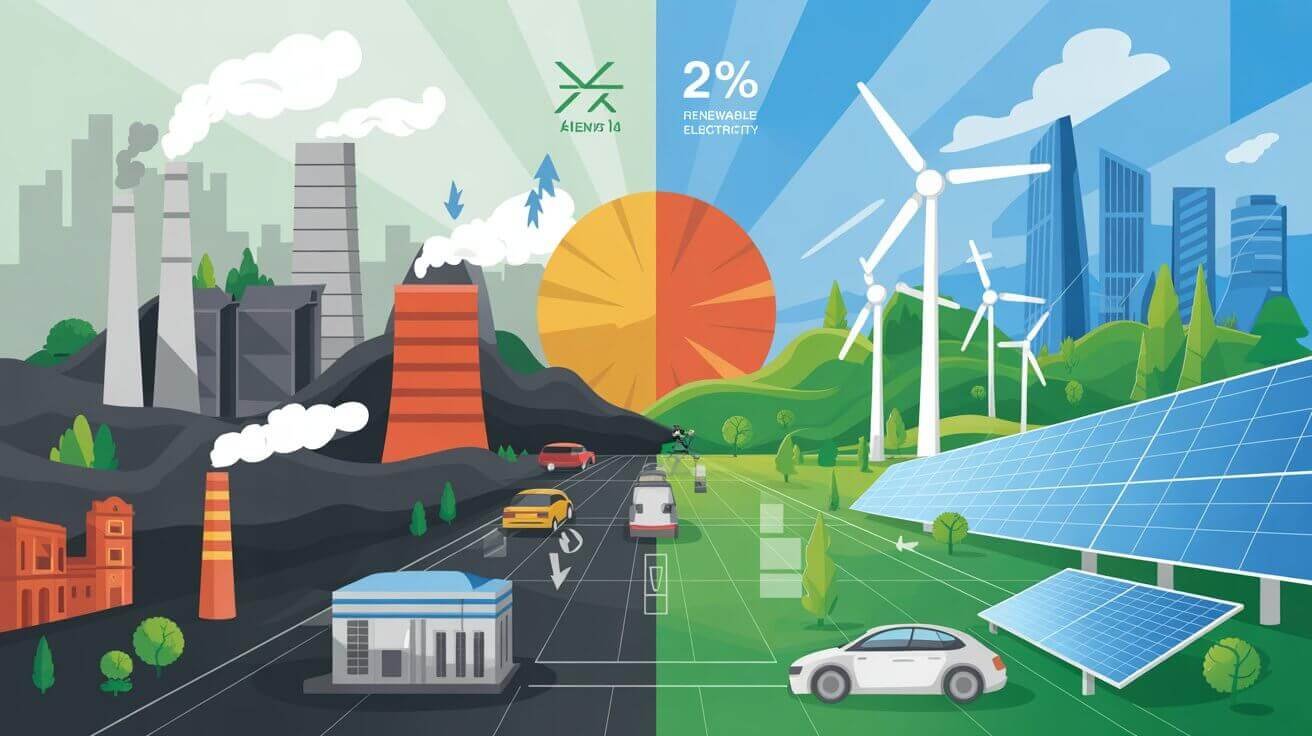China’s transformation into the world’s first electrostate represents one of the most significant economic shifts in modern history. Unlike traditional petrostates that built their economies around fossil fuels, China’s electrostate transition centers on electricity generated from renewable sources as the backbone of its industrial and economic power. This fundamental shift isn’t just changing how China powers itself—it’s reshaping global energy dynamics and forcing other nations to reconsider their own energy strategies.
According to the International Energy Agency, this transition represents a fundamental reordering of global energy markets that could define the next century of economic development.
The scale of China’s renewable energy expansion is staggering. In 2024 alone, the country added 275 GW of solar capacity and 80 GW of wind power, with wind and solar power generation capacity accounting for 89% of new capacity. Furthermore, wind and solar generating 26% of the nation’s electricity in April 2025, marking the highest monthly share on record. These achievements demonstrate how rapidly China’s electrostate transition is accelerating beyond even the most optimistic projections.
The Economic Engine Behind China’s Electrostate Success
Record-Breaking Financial Investment
China’s commitment to becoming an electrostate goes far beyond symbolic gestures. Clean-energy sectors contributed 13.6tn yuan ($1.9tn) to China’s economy overall – just above 10% of total GDP. Additionally, these sectors grew three times as fast as the Chinese economy overall, accounting for 26% of all GDP growth in 2024.
The financial commitment is extraordinary. China invested close to $680 billion in clean tech manufacturing in 2024, according to the International Energy Agency. That’s almost as much as the United States and the E.U. combined. This massive investment strategy demonstrates that China’s electrostate transition isn’t just about environmental goals—it’s a calculated economic strategy for long-term dominance.
Manufacturing Supremacy in Clean Technology
China’s electrostate status stems largely from its overwhelming control of clean energy supply chains. The country produces 90% of the world’s polysilicon for solar panels, 80% of lithium-ion batteries, and 70% of rare earth magnets critical for wind turbines and EVs. This manufacturing dominance means China doesn’t just consume clean energy—it exports the infrastructure for other countries’ energy transitions.
Moreover, China refined three-quarters of the world’s cobalt and 91 percent of its graphite in recent years. This control over critical materials processing gives China significant leverage in global energy markets, similar to how oil-producing nations once controlled petroleum supplies. The U.S. Geological Survey highlights how this concentration of processing capacity creates new geopolitical dependencies.
Transportation Electrification: The Heart of China’s Strategy
Electric Vehicle Revolution
Transportation electrification represents a cornerstone of China’s electrostate transition. “New Energy Vehicles” (battery electric vehicles and plug-in hybrids) now accounting for more than 50% of new car sales in China. This rapid adoption rate significantly exceeds targets set just a few years ago.
The scale extends beyond personal vehicles. China now has more than 550,000 “new energy” buses (>80% of the total bus fleet), with 100% electrification of urban buses having been achieved by 2023. This comprehensive approach to electrifying public transportation showcases how China’s electrostate transition touches every aspect of mobility, as documented by BloombergNEF.
High-Speed Rail Infrastructure
China’s electrostate development includes the world’s most extensive high-speed rail network. More passengers shuttling between China’s two biggest cities are choosing to hop on a bullet train rather than a flight, with Passengers made more than 52 million trips by train between Beijing and Shanghai last year, while only about 8.6 million people took a flight between the two cities. This shift demonstrates how electric transportation infrastructure is reshaping consumer behavior and reducing fossil fuel dependence.
Global Impact of China’s Electrostate Transition
Geopolitical Implications
China’s emergence as the first electrostate is creating new geopolitical dynamics. China, the emerging ElectroState, pursues a divergent technological trajectory more aligned with Europe’s green ambitions, while Three fossil-fuel giants (or PetroStates)—the United States, Saudi Arabia, and Russia—are consolidating influence. This divide between electrostates and petrostates may define international relations for decades.
The economic leverage is becoming apparent through strategic partnerships. Since 2023, Chinese companies have announced $168 billion in foreign investments in clean energy projects, including solar farms in Saudi Arabia, wind turbines in Brazil, and nuclear reactors in Pakistan. These investments create long-term economic dependencies that extend China’s influence globally, as analyzed by the Council on Foreign Relations.
Supply Chain Dependencies
However, China’s dominance also creates vulnerabilities for other nations. India’s government flagged China’s dominance in clean energy gear as a potential risk to its low-carbon transition, advocating a more diverse global supply chain. This concern reflects growing awareness that China’s electrostate transition could create new forms of energy dependency.
The strategic use of supply chain control is already evident. In December 2024, China banned exports to the United States of gallium, germanium, and antimony and restricted exports of graphite, demonstrating how critical mineral control can become a diplomatic tool. The World Trade Organization has documented similar trade restrictions in recent years.
Challenges Facing China’s Electrostate Transition
Coal Dependency Paradox
Despite massive renewable investments, China faces significant challenges in completely transitioning away from fossil fuels. China’s power sector emissions hit record highs last year, driven by a surge in coal consumption. Furthermore, Reuters has reported that China plans to keep building coal-fired power plants through 2030.
This apparent contradiction highlights the complexity of China’s electrostate transition. Renewables like solar and wind are intermittent, requiring coal plants to provide baseload power during shortages. Additionally, Heavy industries—such as steel and cement—still rely on coal for high-temperature processes. The International Renewable Energy Agency emphasizes that grid stability remains a key challenge for renewable integration.
Grid Integration Challenges
The rapid expansion of renewable capacity creates technical challenges that China must address. A combination of increased storage (primarily batteries), ultra-high voltage transmission and market reforms is expected to improve the availability and utilisation of solar and wind generation by 2030. These infrastructure investments are essential for China’s electrostate transition to succeed fully.
Economic Sustainability Concerns
Rapid growth has created oversupply issues in some sectors. After the lightning capacity expansion of the past few years, clean-energy manufacturing is plagued by weak profitability and oversupply. Addressing these market imbalances will be crucial for maintaining momentum in China’s electrostate development.
Future Implications for Global Energy Markets
Timeline for Full Transition
China’s electrostate transition timeline is ambitious but achievable based on current trends. By 2040, China will be emerging as the world’s first major industrial “electrostate” – an economy in which low-emission electrical energy will be the dominant energy mode for most sectors of the economy. This projection assumes continued investment and technological advancement.
The momentum is building rapidly. By 2030, China’s annual electricity generation will increase from ~9,500TWh in 2023-24 to ~12,000TWh, accompanied by a significant reduction in emissions intensity, with High-emission generation (primarily coal) will decline from 62% to ~48%, while low-emission generation (solar, wind, hydro and nuclear) will increase from 38% to ~52%.
Competitive Response from Other Nations
China’s electrostate success is forcing other countries to accelerate their own transitions. US and European cleantech supply chain investment is set to grow 16-fold in 2025 relative to 2022, though this still lags behind Chinese investment levels significantly.
The competitive dynamics are becoming clearer. China has leapfrogged in electrification to become the first major electrostate. Over the past decade, China has increased the electricity share of final energy by 1 percentage point every year to a level of 27 percent in 2022, more than 5 percentage points higher than the United States and Europe. The Rocky Mountain Institute provides detailed analysis of this competitive landscape.
Practical Lessons for Other Countries
Investment Strategy Insights
Countries seeking to follow China’s electrostate model can learn several key lessons. First, comprehensive government support across multiple five-year planning cycles creates the stability needed for massive infrastructure investments. Second, simultaneously building domestic manufacturing capacity and deploying technologies creates positive feedback loops that accelerate cost reductions.
Third, integrating transportation electrification with renewable energy deployment multiplies the benefits of each investment. China’s approach of electrifying buses, trains, and personal vehicles creates substantial demand for clean electricity, justifying expanded renewable capacity.
Policy Framework Requirements
Successful electrostate transitions require coordinated policy frameworks that address supply chains, manufacturing, deployment, and grid integration simultaneously. China’s success demonstrates that piecemeal approaches are insufficient for achieving the scale needed to become competitive globally.
Furthermore, long-term planning horizons are essential. China’s electrostate transition began with strategic investments in the 1990s and 2000s, reaching fruition in the 2020s. Countries starting today must commit to multi-decade strategies to achieve similar results.
The Path Forward: Implications for Global Climate Goals
China’s electrostate transition represents both an opportunity and a challenge for global climate goals. On one hand, China’s massive deployment of renewable technologies is driving down costs worldwide and demonstrating the economic viability of clean energy at scale. On the other hand, the concentration of manufacturing and supply chains in one country creates vulnerabilities and potential barriers to global deployment.
The success of China’s electrostate model will likely determine whether the world meets its 2030 and 2050 climate targets. If China can successfully complete its transition while maintaining economic growth, it will provide a powerful demonstration effect for other developing countries. However, if geopolitical tensions disrupt technology transfer and supply chains, the global transition could slow significantly.
For business leaders and policymakers worldwide, China’s electrostate transition represents a fundamental shift in how energy systems and economic power intersect. Understanding and adapting to this new reality will be essential for success in the emerging clean energy economy, as outlined in the Paris Agreement framework for global climate action. The question isn’t whether the electrostate model will spread globally—it’s how quickly other countries can develop their own versions while managing the dependencies and opportunities that China’s early leadership has created.
The transformation of China into the world’s first electrostate marks the beginning of a new chapter in global energy history, one where electricity from renewable sources becomes the foundation of economic and geopolitical power. How this transition unfolds will shape the next century of human development and environmental sustainability.








